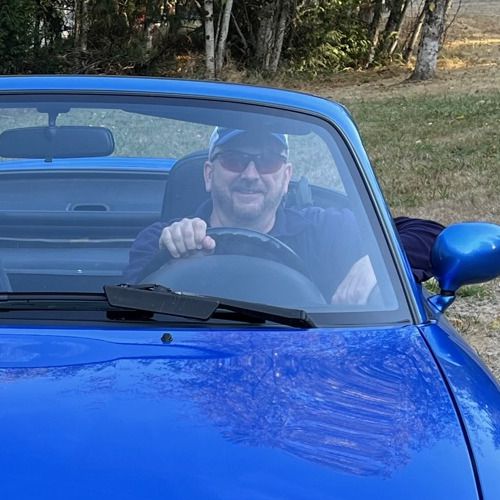Should You Buy a Used R56 Mini Cooper S? - Part 2
00:00 - Should You Buy a Used R56 Mini Cooper S - Part 2
In Part II, I review how some of the common Mini problems that manifested In my R56 Mini Cooper S and I talk about the repairs I had to make to fix these issues to get my Mini back on the road. I even tell you why, in spite of the problems, I still liked my R56 Mini Cooper S.
01:00 - First Round of Repairs
After about year and several thousand relatively trouble-free miles, the trouble began. I was driving on the freeway and notice blue smoke behind the car. I have lived long enough to know this is not a good sign, so I took the next exit and pulled into the nearest parking lot. And yes, there was definitely oil on the front of the engine and on the exhaust.
I towed it to a local Mini repair shop and once I confirmed there was no damage, just a nasty oil leak, I towed the car home and decided to dig into the repairs myself. I was aware of a couple of potential leak areas on the Mini, so I ordered those gaskets and got to work. A complete rundown of round one is in the podcast episode, but here's a bullet list of items I replaced in the first round of repairs:
- Turbo oil feed/return lines - this was the source of the smoke while I was driving on the freeway. I replaced the lines with braided stainless steel lines from Detroit Tuned
- Leaking valve cover - I knew this had a slight leak when I bought the car. Since I was digging into several repairs, I fixed this at the same time, but then noticed one of the valve cover bolts was broken off in the head by some prior owner (Grrrr)
- Oil Filter Housing and Oil Cooler Gaskets - known fail point
- Oil Control Solenoid Gasket Leak - oil leaks out the seal where the oil control solenoid wire passes through the crankcase wall, and if it's not fixed, oil can wick up the solenoid wire into the main wire harness and eventually the DME (i.e. the engine computer).
- Timing Chain Tension Was Worn Out - I checked the timing chain for wear and it was within spec, so it didn't need to be replaced However, the chain tensioner was worn out, so that was replaced.
- Broken Piece of Timing Chain Guide in the Oil Pan - I also had to remove the oil pan when replacing the Oil Control Solenoid, and that's when I discovered a piece of the timing chain guide in the bottom of the pan, so while the timing chain was okay, I ended up replacing it because the plastic/nylon guide was broken.
- Timing Chain Replacement - The timing chain on the R56 Mini Cooper is unlike other timing chains/belts I have replaced. There's no woodruff key to lock it in position on the crankshaft. Instead it has to be lined up accurately in sync with the camshafts and valves, and the entire assembly is held in place simply by the crankshaft and camshaft sprocket bolt tension. If you don't know what this means, that's probably a good thing. What it meant for me was three sweaty attempts to line it up properly over the course of a few days since I got it wrong twice and kept having to drive an hour round trip to the Mini dealer to buy new cam sprocket bolts after I torqued them (Once you put tension on the bolts, you have to toss them out and use new ones).
- Intake Valve Stem Cleaning with Walnut Shells - since I had the whole front of the car off and half the engine disassembled, I decided to clean the intake valves. On direct injection motors of this vintage, the valves experience carbon buildup and have to be manually cleaned every 30K miles or so. Doing this requires a shop vac, a specific shop vac attachment that fits into your intake manifold, an air compressor and a walnut shell blaster with a long metal wand to get down into the engine to clean the valve stems. You also need the patience of a Zen Buddhist monk to carefully rotate the crankshaft to move each piston's intake valves into the closed position, followed by about 2 hours of tightly clenched butt cheeks as you work on a small step ladder to reach the back of the engine. PS - don't forget to wear hearing protection & goggles and have an IPA on standby to celebrate when you're finally finished.
07:00 - Second Round of Repairs - The Body Module Failure
After way too much time had passed, the First Round of repairs were complete and I reassembled the car. The good news? When I started the car, it ran fine. The bad news? The headlights were stuck on, even when the switch was in the "off" position and no other electrical items worked. This was beyond my pay grade, so I bailed out and had it towed to a repair shop.
Apparently something they called a body module had failed. Different people seemed to have different names for this electrical component, but basically it was a module the controlled most of the electrical devices in the car and it stopped working. Just to piss me off more, Mini/BMW had extended the warranty on this part to 10-years and 120K miles because of its failure rate, but I was just outside that time and mileage window, so they wouldn't cover it. Anyway, it was replaced and I went to pick up the car.
08:01 - Third Round of Repairs - Thermostat and Crossover Tube Fails
Driving home from repair shop, I heard a chime and an alert popped up on the main screen (again, there are no useful engine gauges in a Mini Cooper) indicating the car was in limp mode and to go to the "nearest Mini Dealer" (as if you would go to the furthest?) for repairs.
I pulled over and opened the hood and smelled coolant. I then checked underneath and it was clearly leaking a little. I called the shop and they said to let it cool (no problem, I have time for that!) and if it isn't low, I should be able to drive it back or drive it home to diagnose it further. Knowing the Mini shop rates, I drove it home and discovered the thermostat and crossover tube had failed and that was the source of the leak. Apparently this is a common problem on these cars. If I had known that, I would have replaced it as a precaution when it was completely apart. That said, after disassembling part of the car again and waiting for the parts (thank you pandemic-induced parts shortages!), I finally got it fixed and running... but then it wouldn't idle.
09:25 - Fourth Round of Repairs - The Dead High Pressure Fuel Pump
If you don't have a dedicated Mini-specific OBD II scanner for these cars, you would never know what was wrong. Fortunately I did. Unfortunately, when I hooked up the scanner, the code indicated the high pressure fuel pump was dead. Now fortunately the local (30-minutes away) Mini Dealer had the pump in stock. Unfortunately it cost about $900.
Out of options, I drove to the dealer and while waiting for the parts counter person, I asked the service manager if Mini had any record of prior high pressure fuel pump replacement for my car. Turns out the answer was "yes". That original pump was replaced at 57,000 miles. And now that the car was over 120,000 miles (or about 63,500 miles since the last pump failure), it is clear that Mini's $900 high pressure fuel pump doesn't last very long. Seems obvious now, but after all this, I learned that high pressure fuel pumps are a known failure point on these cars, so keep a spare $1K hanging around just in case.
Later, after installing the pump myself to save a couple hundred dollars in shop time, I was so pleased to find out that I had to put the money I saved towards a replacement low-pressure fuel pump, which had also conveniently failed.
Oh, will the pain ever end?!?
By the way, this is a rhetorical question, so there's no need for you to answer. However, after the low-pressure pump was replaced, my Mini Cooper S troubles did seem to come to an end.
10:40 - After All That I Decided To Sell It
After missing one buyer with an unforced error on my part, I found another who really wanted the car. I let the guy drive it for over an hour (with me in the car, of course) and it worked great, so he bought it. And strangely after he left, I started to miss it... not the repair work, but the car.
It's funny, but after all the issues I had, I can honestly still recommend that people consider an R56 Mini Cooper S. Why? Because they are fun to drive.
Of course, knowing all the things I know now (and you now know too) would definitely have factored into my decision to buy one... especially a high mileage one. But I think I still would have bought one - likely one with less miles, and hopefully, less potential problems. And if I was looking at a high-mileage R56 Mini Cooper S, I would have either made certain those typical failure points had been fixed, or I would have passed and waited for a better car. Hopefully my screw-ups help you avoid the same fate.
13:35 - What Should You Look For in an R56 Mini Cooper S
Okay, knowing all the potential problems that could befall one of these cars, if you're still interested in an R56 (and I think you should be, but with a skeptic's eye), here are some things you should look for:
- Buy a car with minimal owners - Preferably one or two owners is best if possible.
- Buy a car with complete maintenance records - consistent oil changes are critical on these vehicles. Owners can say they changed the oil often, but a receipt from a mechanic is proof.
- Confirm the typical failure points have been addressed - As noted earlier, these cars have some known issues, so make sure the maintenance records show that they have been repaired.
- Check the CarFax - Not eveyone likes to do this because it can be expensive, but not as expensive as finding out you bought a bad car. The CarFax can show accidents, title issues, repairs, etc.
- Check exterior condition - panel gaps, paint quality, consistency of the paint color, loose bumper covers, etc. You are looking for evidence of prior damage.
- Check the VIN Tags - check to make sure all the vehicle identification Number (or VIN) tags where they should be
- Check brake pads - Sometimes you can see the brake pads through the wheel (not always), but if not, jack up the car and remove a wheel or two front and rear to check caliper depth. Note: a pre-purchase inspection would cover this.
- Bring a tire depth gauge - It's fine to eyeball tread depth, but I prefer to check tire wear using a gauge. Most people estimate that tire tread is deeper than it actually is.
- Check the interior for damage - The oldest R56 is 15-years old. With proper care, these should not have interior issues, so if there's major interior damage, pass and move to the next car.
- Go for a long test drive. Make sure everything (oil, coolant, etc.) gets up to operating temperature and that there are no leaks. Problems don't typically appear until the vehicle is warmed up.
- Get it on the freeway. Drive fast. Check for alignment issues, noises, strange, pulling to one side or the other, etc.
- Turn off the radio during your test drive - Listen to the car, not the music. You're buying a car, not a concert hall. Save the audio check for the end when the car is parked and turned off.
- Check electrical and mechanical systems - This includes heater, fan, air-conditioning, wipers, sunroof, seat heaters, doors and rear-hatch operation, windows, audio system, blue tooth connection, headlights, turn signals, etc. Be thorough
- Confirm TPMS sensors are in working order - These sensors live in a harsh environment, so confirm they work properly as it can be expensive to replace them.
- Get a Pre-Purchase Inspection - You definitely want to qualify a potential vehicle, first by sifting through ads, then by phone, then in person and finally with a check by a competent Mini-specific mechanic. These cars can have issue, so this is critical.
- Avoid Cars Involved In An Accident - A small dent or minor paint issue is no big deal, but a car involved in a major accident may not be repaired properly, so move on and find another example.
- Avoid Rebuilt or Branded Titles - Just walk away, another car will pop up for sale that's better in a day or two (or an hour).
- Get the N18 motor - The N14 engine found in the 2007-2010 R56 models tends to have more issue than the later N18 motor from the 2011-2013 R56 models. The N18 also offers more power, so that's an added bonus.
- Get the newest example you can find - problems with a particular vehicle model tend to get solved over time, so a 2007 R56 Mini Cooper S will typically have more problems areas than an R56 built for model year 2013.
- Search Autotempest.com - This website provides an easy way to search multiple online search engines at the same time.
- Stick to Mini Coopers with low mileage - This is relative to the model year, but the newest of these is now 9 years old, so there are easily Mini's with over 100K miles, but I would focus on vehicles with less miles (50K to 75K) to avoid potential problems.
23:30 - What Should You Expect To Pay?
The market for used cars is strange now, so these prices might change considerably over the next six to twelve months. With that in mind, these prices reflect what I think you would pay to a private party and possibly some dealers who haven't inflated their prices like many others have.
$5,000 to $7,000 - I paid $4500 for mine, but I would say $5K to $7K is likely not enough to get a trouble-free example. I would expect to have some issues to deal with at this price-point. That said, if you have mechanical skills that you don't mind using, you can save on the cost of repairing known issues. But it's the unknowns that kill you... just sayin'
$8,000 to 11,000 - You should be able to find a nice R56 Mini Cooper S in this price range. I even found a 2013 through a dealership with 56,000 miles for $10,950 just before updating this, so that was refreshing. Some dealers charge a lot more, even thought they really haven't added any value.
$12,000 to $14,000 - I would expect to find the best examples (short of a collector example with zero miles) in this price range. Paying more than this is really just lining the pockets of someone who wants to over charge you for a car. On that note, I saw a 2013 Mini Cooper S with 52,000 miles from a nationwide online retailer asking more than $18,500. It was basically the same car as the retailer I mentioned above selling theirs for $10,950. I don't know about you, but I would prefer to save that $7550, so it pays to shop around.
26:00 - Close of the R56 Mini Cooper S - Part 2
So my recommendation is if you're going to get an R56 Mini Cooper S, get a newer one with the N18 engine, low miles and minimal owners. Look for the any of the problem areas I mentioned earlier and get a pre-purchase inspection. Also, avoid the really over-priced dealership examples, but do spend more for a good car and you will be better off in the long run.


